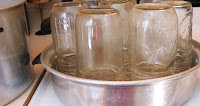A pantry filled with colorful jars of delicious, homegrown foods is a gratifying finish to a summer of tending the garden. In the past I’ve made bread & butter pickles, jams, zucchini relish, basil beans, piccalilli, peach or plum chutney, and various tomato concoctions. They add zip and zing to sandwiches and dinners through long winters when I miss being out in the garden.
 |
| Jars are in the canner and waiting to be sterilized. |
But as much as I love the results, putting up jars of food is not one of my favorite things to do. And I might not do it at all, except for having a steam canner. The hot water bath method was my first canning experience, consisting of babysitting a gigantic pot of water as it took a half hour to come to a boil not just once but twice for each batch of jars.
Then, about ten or so years ago I noticed a steam canner offered through gardening catalogs. The catalog entry implied it would be a more efficient method of canning. Intrigued, I put in my order, and haven’t looked back.
The first time I used the steam canner I was in love with the idea. It holds only a couple quarts of water, in comparison to four gallons used for hot water bath, so it comes to a boil quickly, getting the whole job done much, much quicker.
 |
| The jars have been filled with catsup and are waiting for processing. |
Except for water amounts, the two canning methods are basically the same. Either method can be used to process fruits, tomatoes, and pickled foods. Neither method, however, is for canning vegetables and meats. For those you need a pressure canner.
There are three parts to a steam canner. A pan at the bottom that is about three inches deep, a rack that fits in the pan, and a tall lid that fits over the pan. There are a couple of holes in the lid to vent steam. Seven quart jars, or eight pint jars will fit on the rack. Fewer jars work too, and if you have only one jar to process, that is fine too. This means that steam canning is adaptable to smaller harvests- and with less water to boil, less energy is wasted.
I found on Wikipedia that steam is actually a gas, and it works by carrying the energy of the boiling water. I thought, too, about the cog train that runs on steam and full of passengers climbs Mt. Washington, the highest peak in the northeast. Steam cooks vegetables, heats New York, and powers trains. If it can do all of that, then it seems unquestionable that steam can seal jars of food.
This year I had a yen for a childhood favorite, Grandma’s chow chow, a corn relish. So I made some of that, and three batches of plum chutney since the plum tree did really well, and some tomato catsup. Yum. The pantry is looking well stocked, and winter will be delicious. -jmm
No comments:
Post a Comment